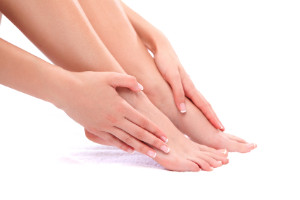
 There are seven tarsal bones that are located on the outer edge of each foot. One of them is referred to as the cuboid bone, which has six sides. Its function is to provide stability for the foot, as this may help to evenly distribute the weight of the body. This bone may be more prone to injury for athletes and ballet dancers. When an injury occurs, the condition referred to as cuboid syndrome may develop. This type of injury can be a result of an ankle sprain, repetitive dance movements, or frequently participating in running and jumping activities. The symptoms that are commonly associated with this condition can include swelling and chronic pain on the outside of the foot, in addition to limited mobility which may make walking difficult. Moderate relief may be felt when the affected foot is elevated, and it may help to wrap the foot in an elastic bandage that can provide support. If you have pain in this area of your foot, please consult with a podiatrist for a proper diagnosis.
There are seven tarsal bones that are located on the outer edge of each foot. One of them is referred to as the cuboid bone, which has six sides. Its function is to provide stability for the foot, as this may help to evenly distribute the weight of the body. This bone may be more prone to injury for athletes and ballet dancers. When an injury occurs, the condition referred to as cuboid syndrome may develop. This type of injury can be a result of an ankle sprain, repetitive dance movements, or frequently participating in running and jumping activities. The symptoms that are commonly associated with this condition can include swelling and chronic pain on the outside of the foot, in addition to limited mobility which may make walking difficult. Moderate relief may be felt when the affected foot is elevated, and it may help to wrap the foot in an elastic bandage that can provide support. If you have pain in this area of your foot, please consult with a podiatrist for a proper diagnosis.
Cuboid syndrome, also known as cuboid subluxation, occurs when the joints and ligaments near the cuboid bone in the foot become torn. If you have cuboid syndrome, consult with Dr. Thomas Tran from Southwestern Foot & Ankle Associates, P.C.. Our doctor will assess your condition and provide you with quality foot and ankle treatment.
Cuboid syndrome is a common cause of lateral foot pain, which is pain on the outside of the foot. The condition may happen suddenly due to an ankle sprain, or it may develop slowly overtime from repetitive tension through the bone and surrounding structures.
Causes
The most common causes of cuboid syndrome include:
Symptoms
A common symptom of cuboid syndrome is pain along the outside of the foot which can be felt in the ankle and toes. This pain may create walking difficulties and may cause those with the condition to walk with a limp.
Diagnosis
Diagnosis of cuboid syndrome is often difficult, and it is often misdiagnosed. X-rays, MRIs and CT scans often fail to properly show the cuboid subluxation. Although there isn’t a specific test used to diagnose cuboid syndrome, your podiatrist will usually check if pain is felt while pressing firmly on the cuboid bone of your foot.
Treatment
Just as the range of causes varies widely, so do treatments. Some more common treatments are ice therapy, rest, exercise, taping, and orthotics.
If you have any questions, please feel free to contact our office located in Frisco, TX . We offer the newest diagnostic and treatment technologies for all your foot care needs.
Copyright © Southwestern Foot and Ankle Associates, P.C. | Site Map | Nondiscimination | Design by: Podiatry Content Connection